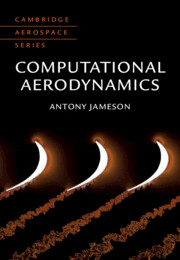Refine search
Actions for selected content:
2076 results in Aerospace engineering
Plates
-
- Book:
- Computational Aerodynamics
- Published online:
- 12 August 2022
- Print publication:
- 01 September 2022, pp 609-612
-
- Chapter
- Export citation
Appendix E - Fundamental Stability Theory II
-
- Book:
- Computational Aerodynamics
- Published online:
- 12 August 2022
- Print publication:
- 01 September 2022, pp 564-582
-
- Chapter
- Export citation
4 - Fundamental Stability Theory
-
- Book:
- Computational Aerodynamics
- Published online:
- 12 August 2022
- Print publication:
- 01 September 2022, pp 97-130
-
- Chapter
- Export citation
8 - The Calculation of Viscous flow
-
- Book:
- Computational Aerodynamics
- Published online:
- 12 August 2022
- Print publication:
- 01 September 2022, pp 276-307
-
- Chapter
- Export citation
1 - Introduction and Background
-
- Book:
- Computational Aerodynamics
- Published online:
- 12 August 2022
- Print publication:
- 01 September 2022, pp 1-9
-
- Chapter
- Export citation
14 - High Order Methods for Unstructured Meshes
-
- Book:
- Computational Aerodynamics
- Published online:
- 12 August 2022
- Print publication:
- 01 September 2022, pp 433-464
-
- Chapter
- Export citation
15 - Aerodynamic Shape Optimization
-
- Book:
- Computational Aerodynamics
- Published online:
- 12 August 2022
- Print publication:
- 01 September 2022, pp 465-495
-
- Chapter
- Export citation
13 - High order Methods for Structured Meshes
-
- Book:
- Computational Aerodynamics
- Published online:
- 12 August 2022
- Print publication:
- 01 September 2022, pp 410-432
-
- Chapter
- Export citation
6 - Shock Capturing Schemes II: Systems of Equations and Gas Dynamics
-
- Book:
- Computational Aerodynamics
- Published online:
- 12 August 2022
- Print publication:
- 01 September 2022, pp 179-222
-
- Chapter
- Export citation
12 - Energy Stability for Nonlinear Problems
-
- Book:
- Computational Aerodynamics
- Published online:
- 12 August 2022
- Print publication:
- 01 September 2022, pp 387-409
-
- Chapter
- Export citation
5 - Shock Capturing Schemes I: Scalar Conservation Laws
-
- Book:
- Computational Aerodynamics
- Published online:
- 12 August 2022
- Print publication:
- 01 September 2022, pp 131-178
-
- Chapter
- Export citation
Frontmatter
-
- Book:
- Computational Aerodynamics
- Published online:
- 12 August 2022
- Print publication:
- 01 September 2022, pp i-vi
-
- Chapter
- Export citation
Index
-
- Book:
- Computational Aerodynamics
- Published online:
- 12 August 2022
- Print publication:
- 01 September 2022, pp 607-608
-
- Chapter
- Export citation
References
-
- Book:
- Computational Aerodynamics
- Published online:
- 12 August 2022
- Print publication:
- 01 September 2022, pp 589-606
-
- Chapter
- Export citation
9 - Overview of Time Integration Methods
-
- Book:
- Computational Aerodynamics
- Published online:
- 12 August 2022
- Print publication:
- 01 September 2022, pp 308-329
-
- Chapter
- Export citation
7 - Discretization Schemes for Flows in Complex Multi-dimensional Domains
-
- Book:
- Computational Aerodynamics
- Published online:
- 12 August 2022
- Print publication:
- 01 September 2022, pp 223-275
-
- Chapter
- Export citation
11 - Time-Accurate Methods for Unsteady Flow
-
- Book:
- Computational Aerodynamics
- Published online:
- 12 August 2022
- Print publication:
- 01 September 2022, pp 367-386
-
- Chapter
- Export citation

Computational Aerodynamics
-
- Published online:
- 12 August 2022
- Print publication:
- 01 September 2022
3 - Megawatt-Scale Electric Machines for Electrified Aircraft Propulsion
-
-
- Book:
- Electrified Aircraft Propulsion
- Published online:
- 11 May 2022
- Print publication:
- 26 May 2022, pp 49-87
-
- Chapter
- Export citation
5 - Conventional Power Electronics for Electrified Aircraft Propulsion
-
-
- Book:
- Electrified Aircraft Propulsion
- Published online:
- 11 May 2022
- Print publication:
- 26 May 2022, pp 130-149
-
- Chapter
- Export citation
